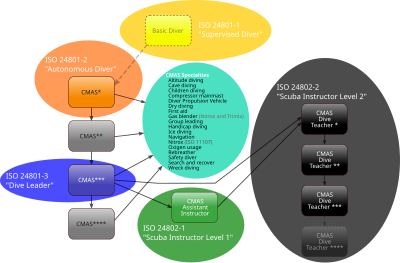CMAS one-star scuba diver (also known as CMAS * diver, or just CMAS *) is the entry-level diving certification for recreational scuba diving issued by the Confédération Mondiale des Activités Subaquatiques (CMAS).
The training programme enables divers to undertake accompanied no-decompression dives to a maximum depth of 20 meters in open water. Other countries affiliated to CMAS may allow higher limits (for example, the Irish Underwater Council certifies a CMAS * diver to dive to 25m or 30m depending on the dive buddy, both at home and abroad).
Principle
In the CMAS International Diver Training Standards and Procedures Manual, CMAS states that "A one-star diver shall be deemed to have sufficient knowledge, skill and experience to procure air, equipment, and other diving services and to plan, conduct, and log open-water dives that do not require mandatory in-water decompression stops, without the supervision of a CMAS instructor or CMAS dive leader, when properly equipped and accompanied by another certified diver of at least the same level, provided the diving activities undertaken, the diving conditions and the diving area are similar, equal or better to those in which training was received."
Prerogatives
CMAS one-star scuba divers can undertake accompanied no-decompression dives to a maximum depth of 20 meters in open water.
Equivalent certifications

The Confédération mondiale des activités subaquatiques (world underwater federation) was created in 1959 to bring consistency between different national diving certification systems.
As a result, the CMAS one-star diver certification is usually delivered as an equivalence to a national one-star diver certification delivered through a federation affiliated to the CMAS Technical Committee.
| Country | Affiliated organisation | Equivalent certification |
|---|---|---|
| France | FFESSM | Level-1 diver ("plongeur niveau 1") |
| Belgium | Royal Belgian Diving Federation (BEFOS-FEBRAS) | Level-1 diver |
| Spain | FEDAS | Level-1 diver |
| Great Britain | Sub-Aqua Association | Open Water Diver |
The CMAS one-star diver certification can also be delivered by specially accredited dive centers known as CMAS Dive Centers (CDC) who use dedicated CMAS training materials and who directly issue CMAS diving certificates.
Course details
The course covers the following theory topics:
- the selection, purpose and function of diving equipment;
- the purpose and use of diving signals;
- diving physics;
- medical problems related to diving
- use of dive tables and dive computers
- the function and use of scuba equipment;
- the mechanisms of respiration and circulation;
- the use of buoyancy devices;
- comparison and selection of diving suits and ancillary equipment;
- methods for care and maintenance of equipment;
- accident prevention, self-rescue and buddy rescue – including theory of emergency ascent, towing, expired air ventilation and cardio-pulmonary resuscitation;
- diving procedures, the role of dive leader, importance of planning and preparation;
- selection of dive sites, the effect of weather and tides, hazards, importance of conservation;
and the following practical skills:
- snorkelling;
- assembly and fitting of scuba equipment;
- entry and exit;
- surface swimming with full scuba equipment (student shall be able to swim a distance of at least 50m);
- proper weighting, buoyancy;
- clearing and replacing mask and mouthpiece;
- out-of-air emergency procedures, using a secondary air supply;
- controlled buoyant lift;
- diver assistance techniques, towing and landing a casualty;
- employing expired air ventilation and cardio-pulmonary resuscitation.
- underwater removal and replacement of scuba and ballast systems
- simple under-water navigation
Following the training, five successful open water dives are required to complete the certification.
The course has the following minimum requirements:
- Theory lessons totalling 385 minutes;
- Practical lessons totalling 480 minutes;
- Five open water dives.
Recommended curricula
Although the CMAS* Diver standard is a minimum requirement, individual CMAS Federations may recommend or require higher standards or extra coverage for their entry-level certification to suit local conditions and requirements. For example, the Sub-Aqua Association in the UK places extra emphasis on the theory and prevention of decompression sickness, diving from small boats and cold-water diving.
References
- "One Star Diver Training Programme". www.cmas.org. Retrieved 23 August 2019.
- "Excerpt from Irish Underwater Council Training and Standards Manual - DIVE BUDDIES, GRADES AND MAXIMUM DEPTHS" (PDF). diving.ie. Retrieved 5 October 2021.
- "CMAS International Diver Training Standards and Procedures Manual". Retrieved 23 August 2019.
- "Federations affiliated to the CMAS Technical Committee". Confédération Mondiale des Activités Subaquatiques. Archived from the original on 13 October 2022. Retrieved 27 October 2012.
- "Welcome to CMAS Instructors South Africa". CMAS Instructors South Africa. Archived from the original on 19 January 2012. Retrieved 28 October 2012.
- "ORGANIZATIONAL STANDARDS". Scuba Educators International. Archived from the original on 20 February 2012. Retrieved 28 October 2012.
- "Federations". www.cmas.org. Retrieved 23 August 2019.
- "Cross Over". Sub-Aqua Association. Retrieved 23 August 2019.
- "CMAS Diving Centers". Confédération Mondiale des Activités Subaquatiques. Archived from the original on 13 October 2022. Retrieved 27 October 2012.
- ^ "CMAS One Star Diver Training Programme (version 2011/4)" (pdf). Confédération Mondiale des Activités Subaquatiques. 6 April 2011. pp. 3–6. Retrieved 10 March 2016.
- Cole, Bob (2009). "Chapter 7". Student Diver Tool Box (second ed.). Sub-Aqua Association. ISBN 0-9532904-9-2.